Abstract
A combination of calorimetric and spectroscopic techniques was used to evaluate the thermodynamic behavior of a set of DNA hairpins with the sequence d(GCGCTnGCGC), where n = 3, 5 and 7, and the interaction of each hairpin with ethidium. All three hairpins melt in two-state monomolecular transitions, with tm's ranging from 79.1 degrees C (T3) to 57.5 degrees C (T7), and transition enthalpies of approximately 38.5 kcal mol-1. Standard thermodynamic profiles at 20 degrees C reveal that the lower stability of the T5 and T7 hairpins corresponds to a delta G degree term of +0.5 kcal mol-1 per thymine residue, due to the entropic ordering of the thymine loops and uptake of counterions. Deconvolution of the ethidium-hairpin calorimetric titration curves indicate two sets of binding sites that correspond to one ligand in the stem with binding affinity, Kb, of approximately 1.8 x 10(6) M-1, and two ligands in the loops with Kb of approximately 4.3 x 10(4) M-1. However, the binding enthalpy, delta Hb, ranges from -8.6 (T3) to -11.6 kcal mol-1 (T7) for the stem site, and -6.6 (T3) to -12.7 kcal mol-1 (T7) for the loop site. Relative to the T3 hairpin, we obtained an overall thermodynamic contribution (per dT residue) of delta delta Hb = delta(T delta Sb) = -0.7(5) kcal mol-1 for the stem sites and delta delta Hb = delta(T delta Sb) = -1.5 kcal mol-1 for the loop sites. Therefore, the induced structural perturbations of ethidium binding results in a differential compensation of favorable stacking interactions with the unfavorable ordering of the ligands.
Full text
PDF
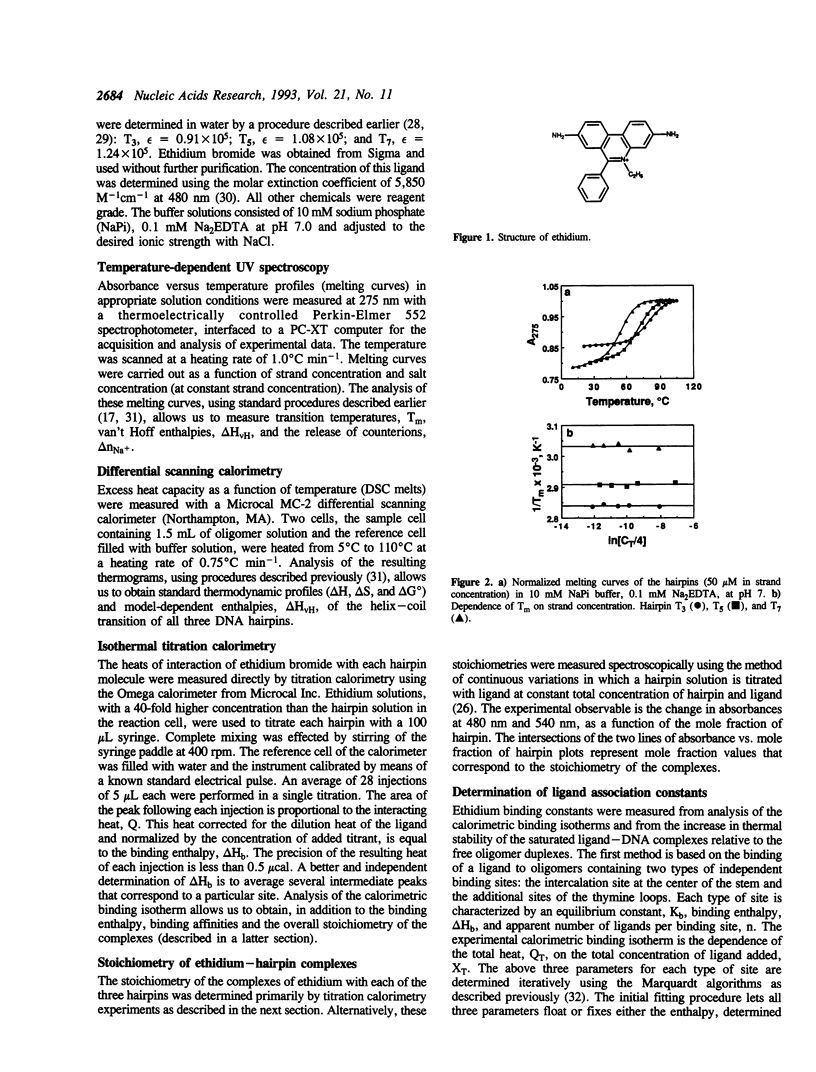
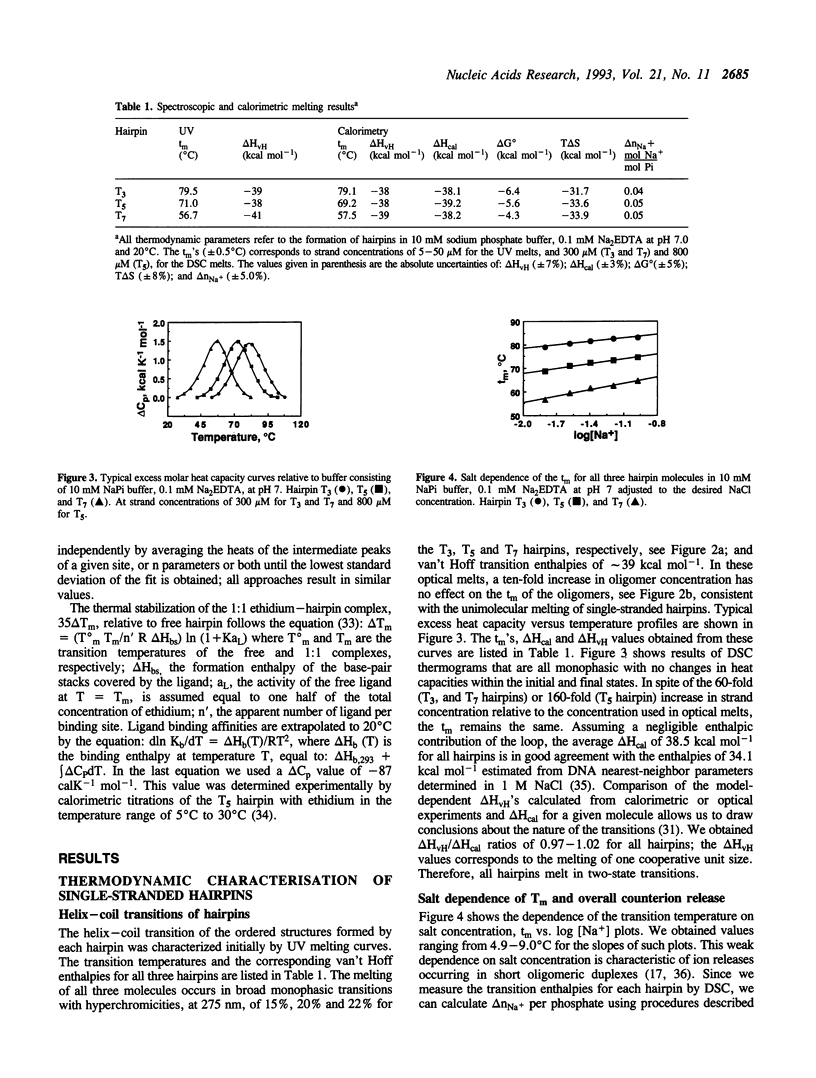
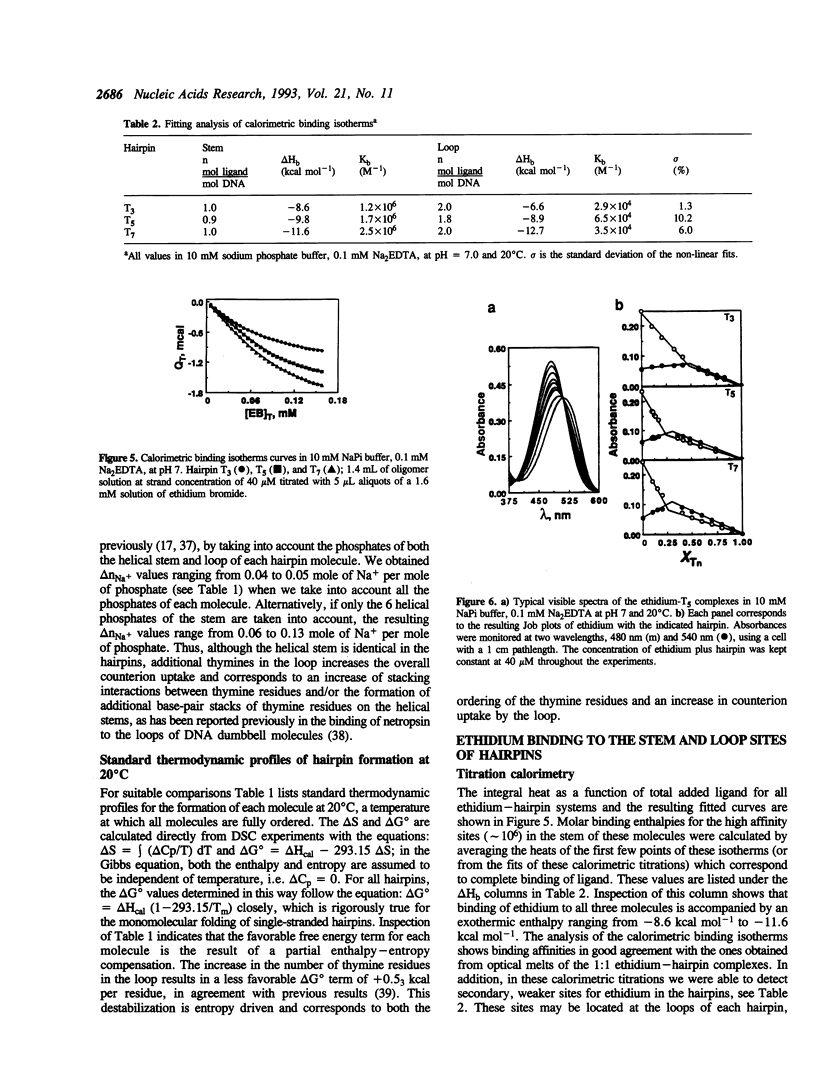
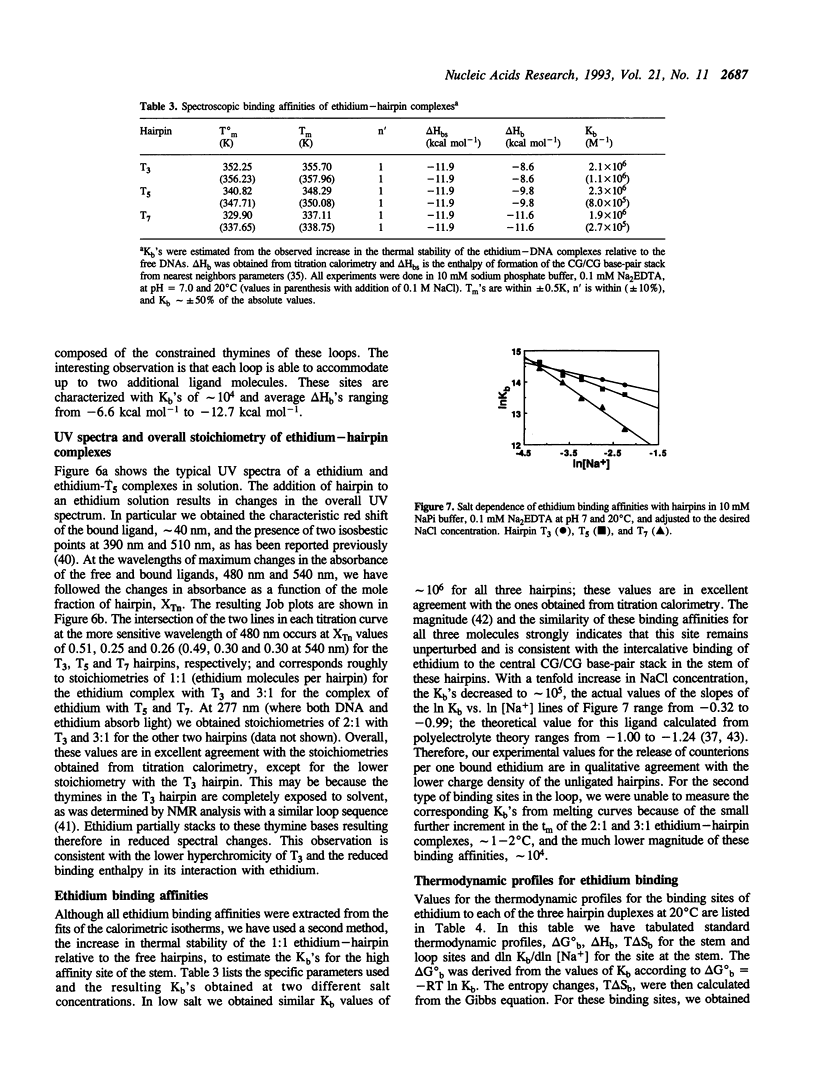
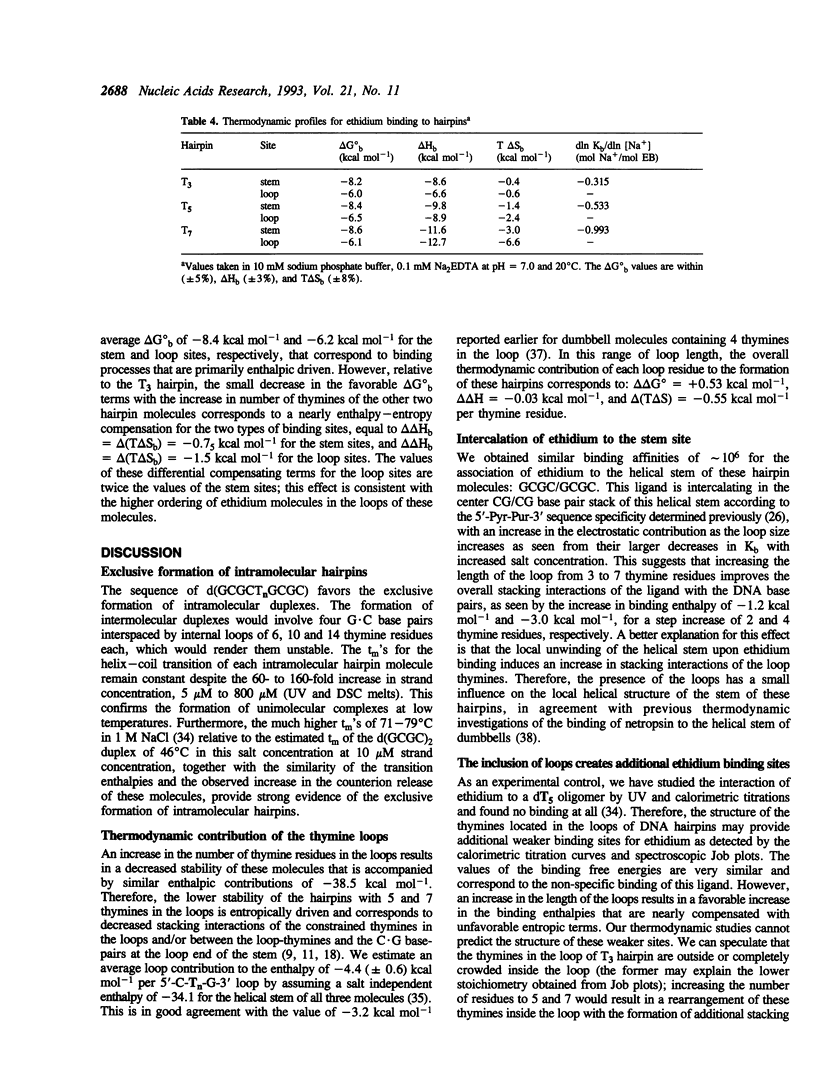

Selected References
These references are in PubMed. This may not be the complete list of references from this article.
- Amaratunga M., Snowden-Ifft E., Wemmer D. E., Benight A. S. Studies of DNA dumbbells. II. Construction and characterization of DNA dumbbells with a 16 base-pair duplex stem and Tn end loops (n = 2, 3, 4, 6, 8, 10, 14). Biopolymers. 1992 Jul;32(7):865–879. doi: 10.1002/bip.360320713. [DOI] [PubMed] [Google Scholar]
- Antao V. P., Tinoco I., Jr Thermodynamic parameters for loop formation in RNA and DNA hairpin tetraloops. Nucleic Acids Res. 1992 Feb 25;20(4):819–824. doi: 10.1093/nar/20.4.819. [DOI] [PMC free article] [PubMed] [Google Scholar]
- Boulard Y., Gabarro-Arpa J., Cognet J. A., Le Bret M., Guy A., Téoule R., Guschlbauer W., Fazakerley G. V. The solution structure of a DNA hairpin containing a loop of three thymidines determined by nuclear magnetic resonance and molecular mechanics. Nucleic Acids Res. 1991 Oct 11;19(19):5159–5167. doi: 10.1093/nar/19.19.5159. [DOI] [PMC free article] [PubMed] [Google Scholar]
- Breslauer K. J., Frank R., Blöcker H., Marky L. A. Predicting DNA duplex stability from the base sequence. Proc Natl Acad Sci U S A. 1986 Jun;83(11):3746–3750. doi: 10.1073/pnas.83.11.3746. [DOI] [PMC free article] [PubMed] [Google Scholar]
- Bresloff J. L., Crothers D. M. DNA-ethidium reaction kinetics: demonstration of direct ligand transfer between DNA binding sites. J Mol Biol. 1975 Jun 15;95(1):103–123. doi: 10.1016/0022-2836(75)90339-3. [DOI] [PubMed] [Google Scholar]
- Bresloff J. L., Crothers D. M. Equilibrium studies of ethidium--polynucleotide interactions. Biochemistry. 1981 Jun 9;20(12):3547–3553. doi: 10.1021/bi00515a038. [DOI] [PubMed] [Google Scholar]
- Cantor C. R., Warshaw M. M., Shapiro H. Oligonucleotide interactions. 3. Circular dichroism studies of the conformation of deoxyoligonucleotides. Biopolymers. 1970;9(9):1059–1077. doi: 10.1002/bip.1970.360090909. [DOI] [PubMed] [Google Scholar]
- Chastain M., Tinoco I., Jr Structural elements in RNA. Prog Nucleic Acid Res Mol Biol. 1991;41:131–177. doi: 10.1016/S0079-6603(08)60008-2. [DOI] [PMC free article] [PubMed] [Google Scholar]
- Chou W. Y., Marky L. A., Zaunczkowski D., Breslauer K. J. The thermodynamics of drug-DNA interactions: ethidium bromide and propidium iodide. J Biomol Struct Dyn. 1987 Oct;5(2):345–359. doi: 10.1080/07391102.1987.10506399. [DOI] [PubMed] [Google Scholar]
- Crothers D. M. Statistical thermodynamics of nucleic acid melting transitions with coupled binding equilibria. Biopolymers. 1971 Nov;10(11):2147–2160. doi: 10.1002/bip.360101110. [DOI] [PubMed] [Google Scholar]
- Friedman R. A., Manning G. S. Polyelectrolyte effects on site-binding equilibria with application to the intercalation of drugs into DNA. Biopolymers. 1984 Dec;23(12):2671–2714. doi: 10.1002/bip.360231202. [DOI] [PubMed] [Google Scholar]
- Gupta G., Sarma M. H., Sarma R. H., Bald R., Engelke U., Oei S. L., Gessner R., Erdmann V. A. DNA hairpin structures in solution: 500-MHz two-dimensional 1H NMR studies on d(CGCCGCAGC) and d(CGCCGTAGC). Biochemistry. 1987 Dec 1;26(24):7715–7723. doi: 10.1021/bi00398a027. [DOI] [PubMed] [Google Scholar]
- Haasnoot C. A., Hilbers C. W., van der Marel G. A., van Boom J. H., Singh U. C., Pattabiraman N., Kollman P. A. On loop folding in nucleic acid hairpin-type structures. J Biomol Struct Dyn. 1986 Apr;3(5):843–857. doi: 10.1080/07391102.1986.10508468. [DOI] [PubMed] [Google Scholar]
- Hare D. R., Reid B. R. Three-dimensional structure of a DNA hairpin in solution: two-dimensional NMR studies and distance geometry calculations on d(CGCGTTTTCGCG). Biochemistry. 1986 Sep 9;25(18):5341–5350. doi: 10.1021/bi00366a053. [DOI] [PubMed] [Google Scholar]
- Hilbers C. W., Haasnoot C. A., de Bruin S. H., Joordens J. J., van der Marel G. A., van Boom J. H. Hairpin formation in synthetic oligonucleotides. Biochimie. 1985 Jul-Aug;67(7-8):685–695. doi: 10.1016/s0300-9084(85)80156-5. [DOI] [PubMed] [Google Scholar]
- Ikuta S., Chattopadhyaya R., Ito H., Dickerson R. E., Kearns D. R. NMR study of a synthetic DNA hairpin. Biochemistry. 1986 Aug 26;25(17):4840–4849. doi: 10.1021/bi00365a018. [DOI] [PubMed] [Google Scholar]
- Jovin T. M., Striker G. Chemical relaxation kinetic studies of E. coli RNA polymerase binding to poly [d(A--T)] using ethidium bromide as a fluorescence probe. Mol Biol Biochem Biophys. 1977;24:245–281. doi: 10.1007/978-3-642-81117-3_7. [DOI] [PubMed] [Google Scholar]
- Krugh T. R., Reinhardt C. G. Evidence for sequence preferences in the intercalative binding of ethidium bromide to dinucleoside monophosphates. J Mol Biol. 1975 Sep 15;97(2):133–162. doi: 10.1016/s0022-2836(75)80031-3. [DOI] [PubMed] [Google Scholar]
- Maniatis T., Ptashne M., Backman K., Kield D., Flashman S., Jeffrey A., Maurer R. Recognition sequences of repressor and polymerase in the operators of bacteriophage lambda. Cell. 1975 Jun;5(2):109–113. doi: 10.1016/0092-8674(75)90018-5. [DOI] [PubMed] [Google Scholar]
- Marky L. A., Blumenfeld K. S., Kozlowski S., Breslauer K. J. Salt-dependent conformational transitions in the self-complementary deoxydodecanucleotide d(CGCAATTCGCG): evidence for hairpin formation. Biopolymers. 1983 Apr;22(4):1247–1257. doi: 10.1002/bip.360220416. [DOI] [PubMed] [Google Scholar]
- Marky L. A., Breslauer K. J. Calculating thermodynamic data for transitions of any molecularity from equilibrium melting curves. Biopolymers. 1987 Sep;26(9):1601–1620. doi: 10.1002/bip.360260911. [DOI] [PubMed] [Google Scholar]
- Paner T. M., Amaratunga M., Benight A. S. Studies of DNA dumbbells. III. Theoretical analysis of optical melting curves of dumbbells with a 16 base-pair duplex stem and Tn end loops (n = 2, 3, 4, 6, 8, 10, 14). Biopolymers. 1992 Jul;32(7):881–892. doi: 10.1002/bip.360320714. [DOI] [PubMed] [Google Scholar]
- Paner T. M., Amaratunga M., Doktycz M. J., Benight A. S. Analysis of melting transitions of the DNA hairpins formed from the oligomer sequences d[GGATAC(X)4GTATCC] (X = A, T, G, C). Biopolymers. 1990 Dec;29(14):1715–1734. doi: 10.1002/bip.360291405. [DOI] [PubMed] [Google Scholar]
- Record M. T., Jr, Anderson C. F., Lohman T. M. Thermodynamic analysis of ion effects on the binding and conformational equilibria of proteins and nucleic acids: the roles of ion association or release, screening, and ion effects on water activity. Q Rev Biophys. 1978 May;11(2):103–178. doi: 10.1017/s003358350000202x. [DOI] [PubMed] [Google Scholar]
- Rentzeperis D., Ho J., Marky L. A. Contribution of loops and nicks to the formation of DNA dumbbells: melting behavior and ligand binding. Biochemistry. 1993 Mar 16;32(10):2564–2572. doi: 10.1021/bi00061a014. [DOI] [PubMed] [Google Scholar]
- Rentzeperis D., Kharakoz D. P., Marky L. A. Coupling of sequential transitions in a DNA double hairpin: energetics, ion binding, and hydration. Biochemistry. 1991 Jun 25;30(25):6276–6283. doi: 10.1021/bi00239a028. [DOI] [PubMed] [Google Scholar]
- Rosenberg M., Court D. Regulatory sequences involved in the promotion and termination of RNA transcription. Annu Rev Genet. 1979;13:319–353. doi: 10.1146/annurev.ge.13.120179.001535. [DOI] [PubMed] [Google Scholar]
- Senior M. M., Jones R. A., Breslauer K. J. Influence of loop residues on the relative stabilities of DNA hairpin structures. Proc Natl Acad Sci U S A. 1988 Sep;85(17):6242–6246. doi: 10.1073/pnas.85.17.6242. [DOI] [PMC free article] [PubMed] [Google Scholar]
- Waring M. J. Complex formation between ethidium bromide and nucleic acids. J Mol Biol. 1965 Aug;13(1):269–282. doi: 10.1016/s0022-2836(65)80096-1. [DOI] [PubMed] [Google Scholar]
- Wells R. D., Goodman T. C., Hillen W., Horn G. T., Klein R. D., Larson J. E., Müller U. R., Neuendorf S. K., Panayotatos N., Stirdivant S. M. DNA structure and gene regulation. Prog Nucleic Acid Res Mol Biol. 1980;24:167–267. doi: 10.1016/s0079-6603(08)60674-1. [DOI] [PubMed] [Google Scholar]
- Wemmer D. E., Chou S. H., Hare D. R., Reid B. R. Duplex-hairpin transitions in DNA: NMR studies on CGCGTATACGCG. Nucleic Acids Res. 1985 May 24;13(10):3755–3772. doi: 10.1093/nar/13.10.3755. [DOI] [PMC free article] [PubMed] [Google Scholar]
- Williamson J. R., Boxer S. G. Multinuclear NMR studies of DNA hairpins. 1. Structure and dynamics of d(CGCGTTGTTCGCG). Biochemistry. 1989 Apr 4;28(7):2819–2831. doi: 10.1021/bi00433a012. [DOI] [PubMed] [Google Scholar]
- Williamson J. R., Boxer S. G. Multinuclear NMR studies of DNA hairpins. 2. Sequence-dependent structural variations. Biochemistry. 1989 Apr 4;28(7):2831–2836. doi: 10.1021/bi00433a013. [DOI] [PubMed] [Google Scholar]
- Wiseman T., Williston S., Brandts J. F., Lin L. N. Rapid measurement of binding constants and heats of binding using a new titration calorimeter. Anal Biochem. 1989 May 15;179(1):131–137. doi: 10.1016/0003-2697(89)90213-3. [DOI] [PubMed] [Google Scholar]
- Wolk S. K., Hardin C. C., Germann M. W., van de Sande J. H., Tinoco I., Jr Comparison of the B- and Z-form hairpin loop structures formed by d(CG)5T4(CG)5. Biochemistry. 1988 Sep 6;27(18):6960–6967. doi: 10.1021/bi00418a043. [DOI] [PubMed] [Google Scholar]
- Xodo L. E., Manzini G., Quadrifoglio F., van der Marel G. A., van Boom J. H. Oligodeoxynucleotide folding in solution: loop size and stability of B-hairpins. Biochemistry. 1988 Aug 23;27(17):6321–6326. doi: 10.1021/bi00417a018. [DOI] [PubMed] [Google Scholar]
- Zieba K., Chu T. M., Kupke D. W., Marky L. A. Differential hydration of dA.dT base pairing and dA and dT bulges in deoxyoligonucleotides. Biochemistry. 1991 Aug 13;30(32):8018–8026. doi: 10.1021/bi00246a020. [DOI] [PubMed] [Google Scholar]


